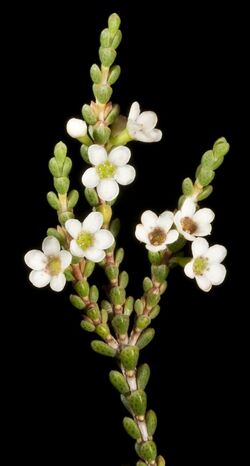Biology:Micromyrtus erichsenii
| Micromyrtus erichsenii | |
|---|---|

| |
| Scientific classification | |
| Kingdom: | Plantae |
| Clade: | Tracheophytes |
| Clade: | Angiosperms |
| Clade: | Eudicots |
| Clade: | Rosids |
| Order: | Myrtales |
| Family: | Myrtaceae |
| Genus: | Micromyrtus |
| Species: | M. erichsenii
|
| Binomial name | |
| Micromyrtus erichsenii Hemsl.[1]
| |
Micromyrtus erichsenii is a species of the family Myrtaceae and is endemic to Western Australia. It is an erect shrub with small, egg-shaped leaves with the narrower end towards the base, and white or cream-coloured flowers 3–4 mm (0.12–0.16 in) in diameter and 5 to 10 stamens.
Description
Micromyrtus erichsenii is an erect shrub that typically grows to 0.3–2.0 m (1 ft 0 in–6 ft 7 in) high. Its leaves are erect to almost pressed against the stem, egg-shaped with the narrower end towards the base, 1.2–2.4 mm (0.047–0.094 in) long and 0.8–1.2 mm (0.031–0.047 in) wide on a petiole 0.3–0.5 mm (0.012–0.020 in) long. The flowers are about 3–4 mm (0.12–0.16 in) in diameter, and arranged in up to 9 upper leaf axils on a peduncle 1.3–2 mm (0.051–0.079 in) long with egg-shaped bracteoles 0.6–1 mm (0.024–0.039 in) long but that fall off as the flower opens. The sepals are broadly egg-shaped, 0.2–0.6 mm (0.0079–0.0236 in) wide and the petals are white or cream-coloured, broadly egg-shaped with the narrower end towards the base and 1.1–1.6 mm (0.043–0.063 in) long. There are 5 to 10 stamens, the anthers about 0.2 mm (0.0079 in) long. Flowering occurs between February and November and the fruit is 1.3–1.7 mm (0.051–0.067 in) long and 0.7–1 mm (0.028–0.039 in) wide containing a single seed.[2][3]
Taxonomy
Micromyrtus erichsenii was first formally described in 1905 by William Hensley in Hooker's Icones Plantarum from specimens collected near Dedari.[4][5] The specific epithet (erichsenii) honours Frederick Ole Erickson.[6]
Distribution and habitat
This species grows on sandplains in shrubland or open woodland between Merredin, Coolgardie, Newdegate and Norseman.[2][3]
References
- ↑ "Micromyrtus erichsenii". https://biodiversity.org.au/nsl/services/apc-format/display/72858. Retrieved 29 October 2023.
- ↑ 2.0 2.1 Rye, Barbara L. (2002). "A revision of south-western Australian species of Micromyrtus (Myrtaceae) with five antisepalous ribs on the hypanthium.". Nuytsia 15 (1): 108–109. https://www.biodiversitylibrary.org/item/310913#page/114/mode/1up. Retrieved 29 October 2023.
- ↑ 3.0 3.1 "Micromyrtus erichsenii". FloraBase. Western Australian Government Department of Parks and Wildlife. https://florabase.dpaw.wa.gov.au/browse/profile/9187.
- ↑ "Micromyrtus erichsenii". APNI. https://id.biodiversity.org.au/instance/apni/484702.
- ↑ Hemsley, William (1905). Icones Plantarum. 28. London: Longman, Rees, Orme, Brown Green and Longman. p. 2780. https://www.biodiversitylibrary.org/item/54441#page/197/mode/1up. Retrieved 29 October 2023.
- ↑ Sharr, Francis Aubi; George, Alex (2019). Western Australian Plant Names and Their Meanings (3rd ed.). Kardinya, WA: Four Gables Press. p. 193. ISBN 9780958034180.
Wikidata ☰ Q15373035 entry
 |

